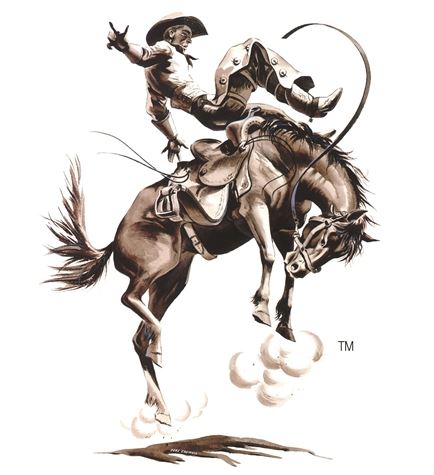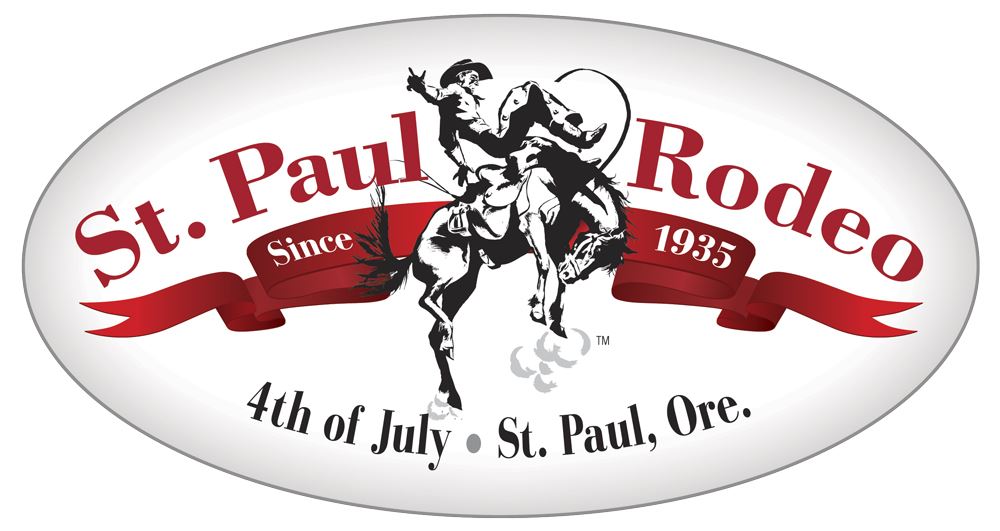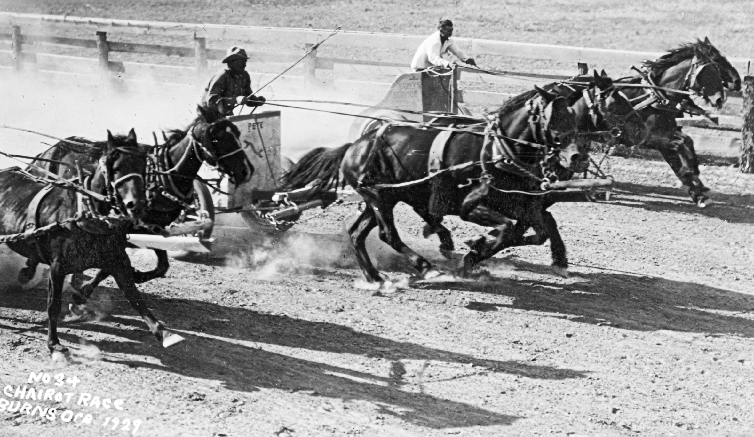On July 4, 1936, the Willamette Valley town of St. Paul held its first rodeo. Lasting four days each year in early July, the rodeo includes a parade, a western art show, and a barbeque cook-off. It is St. Paul’s main tourist attraction and the biggest rodeo held in the United States in a town of such a small size (approximately five hundred people).
In 1935, eight St. Paul farmers and businessmen decided to “support our greater community and honor our western heritage” by establishing a rodeo to help the economically depressed area. They cleaned up the town’s city park and erected seating, four bucking chutes, and a roping chute. The first year, fifty cowboys from around Oregon participated. To promote the rodeo, a royal court was established in 1937 with a queen and two princesses, who were required to have their own horse and equipment. The grandstand, originally built in 1956 and remodeled several times, seats 10,500 people. The arena, located on city land and leased under a special arrangement, is a year-round structure owned by St. Paul Rodeo, a nonprofit corporation. A parade is held on the Fourth of July.
The St. Paul Rodeo is part of the ProRodeo Tour conducted by the Professional Rodeo Cowboys Association, founded in 1936 to establish standards for rodeos in the United States and Canada. Every rodeo has two types of events—three rough stock and five timed. The rough stock events are bareback riding, saddle bronc riding, and bull riding; the timed events consist of steer wrestling, team roping, tie-down roping, barrel racing, and steer roping. In 1991, PRCA recognized the St. Paul Rodeo as the finest rodeo in the Northwest, and the rodeo received the PRCA Remuda Award in 2019 for the "best, most consistent pen of bucking horses.” The total purse paid out at the St. Paul Rodeo in 2019 was over $375,000.
The St. Paul Rodeo Wild West Art Show was first held in 1995, with thirty-four artists participating. The show attracts artists from throughout the West, and awards are presented for best sculpture, watercolor, oil/acrylic, and other media. There are also two student awards and a Western Heritage Award.
A Rodeo Hall of Fame was established by the St. Paul Rodeo Association in 1998 to recognize outstanding competitors in the rodeo’s history. Inductees include champions, stock contractors, contract acts, local committee members, and exceptional horses or bulls. Two of the first inductees went on to national fame—Larry Mahan, who grew up in Brooks, was a six-time All-Around World Champion; and Mel Lambert, who started his career in Bend, became a nationally recognized rodeo announcer, including a twenty-nine-year stint at St. Paul.
The nonprofit St. Paul Rodeo Foundation was formed in 1998 to support education, local history, and western heritage. The foundation provides scholarships to members of the Royal Court and to two high school students headed for college. The foundation contributes to community and regional organizations as well as to the Justin Cowboy Crisis Fund, which provides financial assistance to cowboys injured in rodeos.
Over 50,000 people attend the event each year, requiring year-round planning and community cooperation. The rodeo has become an important Oregon cultural event and provides St. Paul with a significant economic boost, thus fulfilling its founding principles.
-
![]()
Cowboy from the official logo for the St. Paul Rodeo.
Courtesy St. Paul Rodeo -
![]()
Logo for the St. Paul Rodeo.
Courtesy St. Paul Rodeo -
![]()
Pony Express race at the St. Paul Rodeo.
Courtesy St. Paul Rodeo -
![]()
Procession of the St. Paul Rodeo royalty.
Courtesy St. Paul Rodeo -
![]()
Professional clown Bill Lane performed at the St. Paul Rodeo in 1959..
Courtesy Oregon Hist. Soc. Research Lib., Journal, 011794
-
![]()
Calf roping at St. Paul Rodeo, July 4, 1940.
Oregon Historical Society Research Library, Digital Collections, Al Monner, photographer, OrgLot1284_0184_1
-
![]()
Spectators at St. Paul Rodeo, July 4, 1940.
Oregon Historical Society Research Library, Digital Collections, Al Monner, photographer, OrgLot1284_0184_3
-
![]()
Spectators at St. Paul Rodeo, July 4, 1940.
Oregon Historical Society Research Library, Digital Collections, Al Monner, photographer, OrgLot1284_0184_2
Related Entries
-
Harney County Fair, Rodeo, and Race Meet
The first “fair” in Harney County was a media event. On July 4, 1888, a…
-
![Pendleton Round-Up]()
Pendleton Round-Up
The Pendleton Round-Up began in September 1910 as a frontier exhibition…
-
![Rogue River Roundup]()
Rogue River Roundup
In 1916, Ashland dedicated its much-expanded Lithia Park, a ceremony so…
-
![St. Paul]()
St. Paul
St. Paul was one of the first white settlements in Oregon, established …
Related Historical Records
Map This on the Oregon History WayFinder
The Oregon History Wayfinder is an interactive map that identifies significant places, people, and events in Oregon history.
Further Reading
Smith, Gene. The St. Paul Rodeo: My Labor of Love. Salem, Ore.: Eagle Web Press, 2000.
St. Paul Rodeo. https://www.stpaulrodeo.com/












